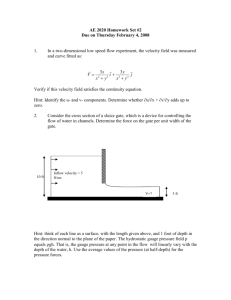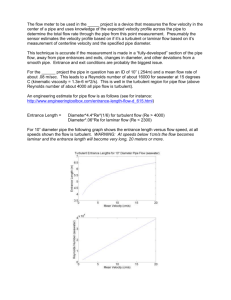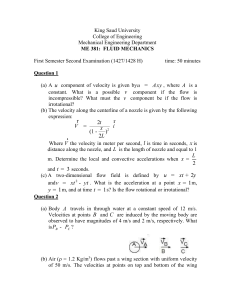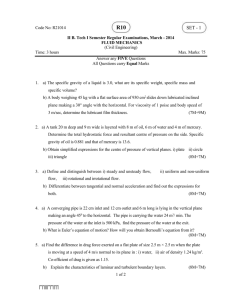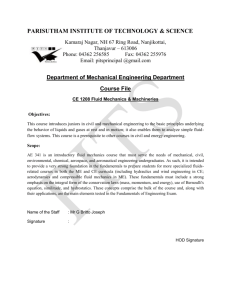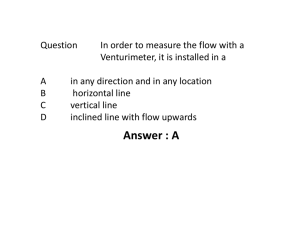Reg - Study Channel
advertisement
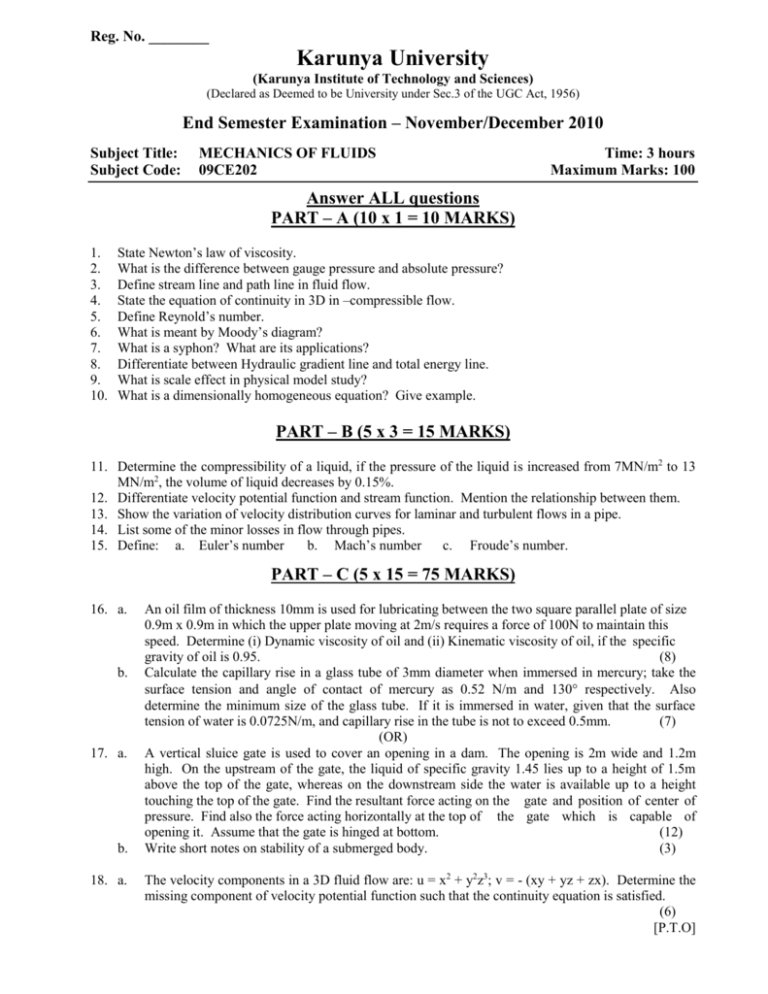
Reg. No. ________ Karunya University (Karunya Institute of Technology and Sciences) (Declared as Deemed to be University under Sec.3 of the UGC Act, 1956) End Semester Examination – November/December 2010 Subject Title: Subject Code: MECHANICS OF FLUIDS 09CE202 Time: 3 hours Maximum Marks: 100 Answer ALL questions PART – A (10 x 1 = 10 MARKS) 1. 2. 3. 4. 5. 6. 7. 8. 9. 10. State Newton’s law of viscosity. What is the difference between gauge pressure and absolute pressure? Define stream line and path line in fluid flow. State the equation of continuity in 3D in –compressible flow. Define Reynold’s number. What is meant by Moody’s diagram? What is a syphon? What are its applications? Differentiate between Hydraulic gradient line and total energy line. What is scale effect in physical model study? What is a dimensionally homogeneous equation? Give example. PART – B (5 x 3 = 15 MARKS) 11. Determine the compressibility of a liquid, if the pressure of the liquid is increased from 7MN/m2 to 13 MN/m2, the volume of liquid decreases by 0.15%. 12. Differentiate velocity potential function and stream function. Mention the relationship between them. 13. Show the variation of velocity distribution curves for laminar and turbulent flows in a pipe. 14. List some of the minor losses in flow through pipes. 15. Define: a. Euler’s number b. Mach’s number c. Froude’s number. PART – C (5 x 15 = 75 MARKS) 16. a. b. 17. a. b. 18. a. An oil film of thickness 10mm is used for lubricating between the two square parallel plate of size 0.9m x 0.9m in which the upper plate moving at 2m/s requires a force of 100N to maintain this speed. Determine (i) Dynamic viscosity of oil and (ii) Kinematic viscosity of oil, if the specific gravity of oil is 0.95. (8) Calculate the capillary rise in a glass tube of 3mm diameter when immersed in mercury; take the surface tension and angle of contact of mercury as 0.52 N/m and 130 respectively. Also determine the minimum size of the glass tube. If it is immersed in water, given that the surface tension of water is 0.0725N/m, and capillary rise in the tube is not to exceed 0.5mm. (7) (OR) A vertical sluice gate is used to cover an opening in a dam. The opening is 2m wide and 1.2m high. On the upstream of the gate, the liquid of specific gravity 1.45 lies up to a height of 1.5m above the top of the gate, whereas on the downstream side the water is available up to a height touching the top of the gate. Find the resultant force acting on the gate and position of center of pressure. Find also the force acting horizontally at the top of the gate which is capable of opening it. Assume that the gate is hinged at bottom. (12) Write short notes on stability of a submerged body. (3) The velocity components in a 3D fluid flow are: u = x2 + y2z3; v = - (xy + yz + zx). Determine the missing component of velocity potential function such that the continuity equation is satisfied. (6) [P.T.O] b. 19. a. b. c. 20. a. b. 21. a. b. 22. a. b. 23. a. b. Derive the first principles, the Euler’s equation of motion for a steady flow along a stream line. Hence derive Bernoulli’s equation. State the various assumptions involved in the above derivation. (9) (OR) Obtain an expression for continuity equation in Cartesian coordinates. (8) The two dimensional stream function for a flow is = 9 + 6x – 4y + 7xy. Find the velocity potential. (4) List various types of fluid flow. (3) Derive Hagen poiseuille’s equation and state the assumptions made. (10) An orifice meter with orifice diameter 15cm is inserted in a pipe of 30cm diameter. The pressure of the upstream and downstream of orifice meter is 14.7 kN/m2 and 9.81 kN/m2. Find the discharge, if Cd = 0.6. (5) (OR) Write short notes on various flow measuring instruments. (4) An existing 300mm diameter pipeline of 3200 m length connects two reservoirs having 13m difference in their water levels. Calculate the discharge Q1. If the parallel pipe 300mm in diameter is attached to the last 1600m length of the above existing pipeline, find the new discharge Q2. What is the change in discharge? Express it as a percentage of Q1. Assume friction factor (f) = 0.04 in Darcy’s –weisbach formula. (11) Define equivalent pipe and write Dupuit’s equation. (4) The discharge of water through a horizontal pipe is 0.25m3/sec. The diameter of above pipe which is 200mm suddenly enlarges to 400mm at a point. If the pressure of water in the smaller diameter of pipe is 120kN/m2., determine (11) (i) loss of head due to sudden enlargement. (ii) pressure of water in the larger pipe and (iii) power lost due to sudden enlargement. (OR) A pipe line 2000m long is used for power transmission 110 kW is to be transmitted through the pipe in which water having a pressure of 5000 KN/m2 at inlet is flowing. If the pressure drop over a length of pipe is 1000 kN/m2 and coefficient of friction is 0.0065, find the diameter of the pipe and efficiency of transmission. (5) Three pipes of diameters 300mm, 200mm and 400mm and lengths 300m, 170m and 210m respectively are connected in series. The difference in water surface levels in two tanks is 12m. Determine the rate of flow if coefficient of friction are 0.005, 0.0052 and 0.0048 respectively. Considering i) Minor losses and (ii) Neglecting minor losses. (10) Define Buckingham theorem. (3) Model of an air duct operating with water produces a pressure drop of 10 kN/m2 over 10m length. If the scale ratio is 1/50. Density of water is 1000 kg/m3 and density of air is 1.2 kg/m2. Viscosity of water is 0.001 NS/m2 and viscosity of air is 0.00002 NS/m2. Estimate corresponding drop in a 20m long air duct. (12) (OR) 25. Check the following equations are dimensionally homogeneous. 24. a. b. a. b. Drag force = Cd 1 U 2 A (3) 2 (U1 U 2 ) F Q ( P1 A1 P2 A2 ) g c. Total energy per unit mass = d. Q 8 Cd tan( / 2) 15 U = velocity; (3) V2 p gz 2 (4) 2g H 5/ 2 = wt density; (5) p = pressure (kg/m2); = density.



